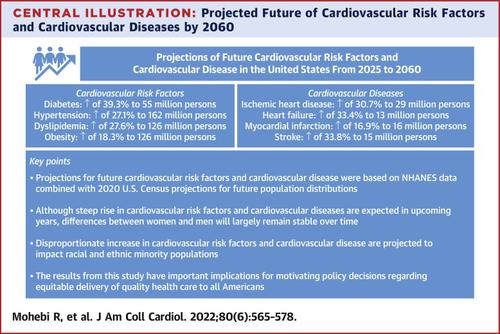Journal of the American College of Cardiology ( IF 24.0 ) Pub Date : 2022-08-01 , DOI: 10.1016/j.jacc.2022.05.033 Reza Mohebi 1 , Chen Chen 1 , Nasrien E Ibrahim 2 , Cian P McCarthy 1 , Hanna K Gaggin 1 , Daniel E Singer 3 , Emily P Hyle 1 , Jason H Wasfy 1 , James L Januzzi 4

|
Background
Understanding trends in cardiovascular (CV) risk factors and CV disease according to age, sex, race, and ethnicity is important for policy planning and public health interventions.
Objectives
The goal of this study was to project the number of people with CV risk factors and disease and further explore sex, race, and ethnical disparities.
Methods
The prevalence of CV risk factors (diabetes mellitus, hypertension, dyslipidemia, and obesity) and CV disease (ischemic heart disease, heart failure, myocardial infarction, and stroke) according to age, sex, race, and ethnicity was estimated by using logistic regression models based on 2013-2018 National Health and Nutrition Examination Survey data and further combining them with 2020 U.S. Census projection counts for years 2025-2060.
Results
By the year 2060, compared with the year 2025, the number of people with diabetes mellitus will increase by 39.3% (39.2 million [M] to 54.6M), hypertension by 27.2% (127.8M to 162.5M), dyslipidemia by 27.5% (98.6M to 125.7M), and obesity by 18.3% (106.3M to 125.7M). Concurrently, projected prevalence will similarly increase compared with 2025 for ischemic heart disease by 31.1% (21.9M to 28.7M), heart failure by 33.0% (9.7M to 12.9M), myocardial infarction by 30.1% (12.3M to 16.0M), and stroke by 34.3% (10.8M to 14.5M). Among White individuals, the prevalence of CV risk factors and disease is projected to decrease, whereas significant increases are projected in racial and ethnic minorities.
Conclusions
Large future increases in CV risk factors and CV disease prevalence are projected, disproportionately affecting racial and ethnic minorities. Future health policies and public health efforts should take these results into account to provide quality, affordable, and accessible health care.
中文翻译:

基于 2020 年人口普查估计的美国心血管疾病预测
背景
根据年龄、性别、种族和民族了解心血管 (CV) 危险因素和心血管疾病的趋势对于政策规划和公共卫生干预非常重要。
目标
本研究的目的是预测患有心血管疾病风险因素和疾病的人数,并进一步探索性别、种族和种族差异。
方法
使用逻辑回归估计不同年龄、性别、种族和民族的心血管危险因素(糖尿病、高血压、血脂异常和肥胖)和心血管疾病(缺血性心脏病、心力衰竭、心肌梗塞和中风)的患病率模型基于 2013-2018 年全国健康和营养调查数据,并进一步与 2025-2060 年的 2020 年美国人口普查预测数相结合。
结果
到2060年,与2025年相比,糖尿病人数将增加39.3%(3920万[M]至5460万),高血压增加27.2%(1.278亿至1.625亿),血脂异常增加27.5% (98.6M 至 125.7M),肥胖增加 18.3%(106.3M 至 125.7M)。同时,与 2025 年相比,缺血性心脏病的预计患病率将同样增加 31.1%(2190 万至 2870 万),心力衰竭增加 33.0%(970 万至 1290 万),心肌梗塞增加 30.1%(1230 万至 1600 万) , 行程增加 34.3% (10.8M 至 14.5M)。在白人中,心血管风险因素和疾病的患病率预计会下降,而少数种族和少数民族的患病率预计会显着增加。
结论
预计未来 CV 风险因素和 CV 疾病患病率将大幅增加,不成比例地影响种族和少数民族。未来的卫生政策和公共卫生工作应考虑这些结果,以提供优质、负担得起和可及的医疗保健。



























 京公网安备 11010802027423号
京公网安备 11010802027423号